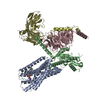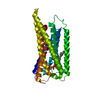+ Open data
Open data
- Basic information
Basic information
| Entry | Database: PDB / ID: 8xbi | ||||||
|---|---|---|---|---|---|---|---|
| Title | Human GPR34 -Gi complex bound to M1, receptor focused | ||||||
 Components Components | Probable G-protein coupled receptor 34 | ||||||
 Keywords Keywords |  MEMBRANE PROTEIN / MEMBRANE PROTEIN /  GPCR GPCR | ||||||
| Function / homology |  Function and homology information Function and homology informationG protein-coupled purinergic nucleotide receptor activity / G protein-coupled receptor activity / G protein-coupled receptor signaling pathway /  plasma membrane plasma membraneSimilarity search - Function | ||||||
| Biological species |   Homo sapiens (human) Homo sapiens (human) | ||||||
| Method |  ELECTRON MICROSCOPY / ELECTRON MICROSCOPY /  single particle reconstruction / single particle reconstruction /  cryo EM / Resolution: 3.06 Å cryo EM / Resolution: 3.06 Å | ||||||
 Authors Authors | Kawahara, R. / Shihoya, W. / Nureki, O. | ||||||
| Funding support |  Japan, 1items Japan, 1items
| ||||||
 Citation Citation |  Journal: Nat Commun / Year: 2024 Journal: Nat Commun / Year: 2024Title: Structural basis for lysophosphatidylserine recognition by GPR34. Authors: Tamaki Izume / Ryo Kawahara / Akiharu Uwamizu / Luying Chen / Shun Yaginuma / Jumpei Omi / Hiroki Kawana / Fengjue Hou / Fumiya K Sano / Tatsuki Tanaka / Kazuhiro Kobayashi / Hiroyuki H ...Authors: Tamaki Izume / Ryo Kawahara / Akiharu Uwamizu / Luying Chen / Shun Yaginuma / Jumpei Omi / Hiroki Kawana / Fengjue Hou / Fumiya K Sano / Tatsuki Tanaka / Kazuhiro Kobayashi / Hiroyuki H Okamoto / Yoshiaki Kise / Tomohiko Ohwada / Junken Aoki / Wataru Shihoya / Osamu Nureki /  Abstract: GPR34 is a recently identified G-protein coupled receptor, which has an immunomodulatory role and recognizes lysophosphatidylserine (LysoPS) as a putative ligand. Here, we report cryo-electron ...GPR34 is a recently identified G-protein coupled receptor, which has an immunomodulatory role and recognizes lysophosphatidylserine (LysoPS) as a putative ligand. Here, we report cryo-electron microscopy structures of human GPR34-G complex bound with one of two ligands bound: either the LysoPS analogue S3E-LysoPS, or M1, a derivative of S3E-LysoPS in which oleic acid is substituted with a metabolically stable aromatic fatty acid surrogate. The ligand-binding pocket is laterally open toward the membrane, allowing lateral entry of lipidic agonists into the cavity. The amine and carboxylate groups of the serine moiety are recognized by the charged residue cluster. The acyl chain of S3E-LysoPS is bent and fits into the L-shaped hydrophobic pocket in TM4-5 gap, and the aromatic fatty acid surrogate of M1 fits more appropriately. Molecular dynamics simulations further account for the LysoPS-regioselectivity of GPR34. Thus, using a series of structural and physiological experiments, we provide evidence that chemically unstable 2-acyl LysoPS is the physiological ligand for GPR34. Overall, we anticipate the present structures will pave the way for development of novel anticancer drugs that specifically target GPR34. | ||||||
| History |
|
- Structure visualization
Structure visualization
| Structure viewer | Molecule:  Molmil Molmil Jmol/JSmol Jmol/JSmol |
|---|
- Downloads & links
Downloads & links
- Download
Download
| PDBx/mmCIF format |  8xbi.cif.gz 8xbi.cif.gz | 75.7 KB | Display |  PDBx/mmCIF format PDBx/mmCIF format |
|---|---|---|---|---|
| PDB format |  pdb8xbi.ent.gz pdb8xbi.ent.gz | 54.3 KB | Display |  PDB format PDB format |
| PDBx/mmJSON format |  8xbi.json.gz 8xbi.json.gz | Tree view |  PDBx/mmJSON format PDBx/mmJSON format | |
| Others |  Other downloads Other downloads |
-Validation report
| Arichive directory |  https://data.pdbj.org/pub/pdb/validation_reports/xb/8xbi https://data.pdbj.org/pub/pdb/validation_reports/xb/8xbi ftp://data.pdbj.org/pub/pdb/validation_reports/xb/8xbi ftp://data.pdbj.org/pub/pdb/validation_reports/xb/8xbi | HTTPS FTP |
|---|
-Related structure data
| Related structure data |  38219MC  8xbeC  8xbgC  8xbhC M: map data used to model this data C: citing same article ( |
|---|---|
| Similar structure data | Similarity search - Function & homology  F&H Search F&H Search |
- Links
Links
- Assembly
Assembly
| Deposited unit | 
|
|---|---|
| 1 |
|
- Components
Components
| #1: Protein | Mass: 45702.742 Da / Num. of mol.: 1 Source method: isolated from a genetically manipulated source Source: (gene. exp.)   Homo sapiens (human) / Gene: GPR34 / Production host: Homo sapiens (human) / Gene: GPR34 / Production host:   Spodoptera frugiperda (fall armyworm) / References: UniProt: Q9UPC5 Spodoptera frugiperda (fall armyworm) / References: UniProt: Q9UPC5 |
|---|---|
| #2: Chemical | ChemComp-KW3 / ( |
| Has ligand of interest | Y |
-Experimental details
-Experiment
| Experiment | Method:  ELECTRON MICROSCOPY ELECTRON MICROSCOPY |
|---|---|
| EM experiment | Aggregation state: PARTICLE / 3D reconstruction method:  single particle reconstruction single particle reconstruction |
- Sample preparation
Sample preparation
| Component | Name: Human GPR34-Gi complex bound to M1,receptor focused / Type: COMPLEX / Entity ID: #1 / Source: RECOMBINANT |
|---|---|
| Molecular weight | Experimental value: NO |
| Source (natural) | Organism:   Homo sapiens (human) Homo sapiens (human) |
| Source (recombinant) | Organism:   Spodoptera frugiperda (fall armyworm) Spodoptera frugiperda (fall armyworm) |
| Buffer solution | pH: 8 |
| Specimen | Conc.: 12 mg/ml / Embedding applied: NO / Shadowing applied: NO / Staining applied : NO / Vitrification applied : NO / Vitrification applied : YES : YES |
Vitrification | Cryogen name: ETHANE |
- Electron microscopy imaging
Electron microscopy imaging
| Experimental equipment |  Model: Titan Krios / Image courtesy: FEI Company |
|---|---|
| Microscopy | Model: FEI TITAN KRIOS |
| Electron gun | Electron source : :  FIELD EMISSION GUN / Accelerating voltage: 300 kV / Illumination mode: FLOOD BEAM FIELD EMISSION GUN / Accelerating voltage: 300 kV / Illumination mode: FLOOD BEAM |
| Electron lens | Mode: BRIGHT FIELD Bright-field microscopy / Nominal defocus max: 2500 nm / Nominal defocus min: 500 nm Bright-field microscopy / Nominal defocus max: 2500 nm / Nominal defocus min: 500 nm |
| Image recording | Electron dose: 50 e/Å2 / Film or detector model: GATAN K3 (6k x 4k) |
- Processing
Processing
CTF correction | Type: PHASE FLIPPING AND AMPLITUDE CORRECTION |
|---|---|
3D reconstruction | Resolution: 3.06 Å / Resolution method: FSC 0.143 CUT-OFF / Num. of particles: 236096 / Symmetry type: POINT |
 Movie
Movie Controller
Controller






 PDBj
PDBj









